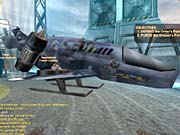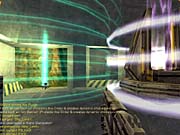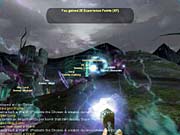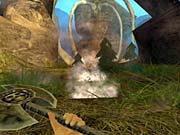During the heyday of the original Quake in 1996 and 1997, several Quake mods rose to prominence. These included the first ever team-based first-person shooters, including the Lithium CTF mod, Team Fortress, and Future vs. Fantasy. In fact, Future vs. Fantasy was one of the most original and popular Quake mods available at the time, pitting several high-tech classes against characters pulled from the fantasy genre. The creators of Future vs. Fantasy have now released an updated version of their game on the more modern Lithtech engine, changing the name to Purge but keeping much of the vision and design from the original game intact. More than six years after the initial release of Future vs. Fantasy for Quake, Purge still offers gameplay that is fairly unique. Unfortunately, balance issues, poor level design, and a lack of online players keep it from fully realizing its potential. Since the game is an online-only multiplayer shooter, the lack of other players is particularly troublesome.

The premise of Purge is a war between humans who have embraced high technology (the Order), and humans who have shunned it in favor of magic and mysticism (the Chosen). There are four classes for each side: androids, cyborgs, commandos and wastelanders on the Order and mages, fighters, assassins, and monks opposing them on the Chosen. Each player class has seven different attributes, and while the game includes four preloaded settings for each of the eight classes, it is also possible to manually tweak the attributes to customize each class as you see fit. Additionally, each class has four different weapons and three special skills it can use in combat.
Doing some simple arithmetic, we see that Purge has 32 different subclasses, 24 skills, and 32 weapons, which seems like a lot of variety on the surface. Unfortunately, as you play the game, you'll find that the four main classes on each side are more or less analogues of one another. Eight of the 12 skills on each side have mirrored equivalents on the other side, further cutting into the variety. Even many of the weapons are extremely similar when compared across sides. For instance, the assassin's vorpal crossbow and fire trap really aren't any different from the commando's gauss sniper rifle and proximity mine. The end result of all this duplication is that both the Order and the Chosen play about the same, despite their cosmetic differences.
Each map features a spawn point for each team called a portal. The portal has a certain number of hit points, and the condition of the portal affects how quickly a team's members can respawn after dying. The object of the game is to destroy the other team's portal. As players kill enemies and perform other tasks to help their team, such as destroying enemy structures or dropping upgrades for their teammates, they'll gain experience that will eventually allow them to level up and enhance their skills and natural attributes. Though, much like in Freelancer's multiplayer model, experience points gained on one server are stored only on that server (and only if that server is running the persistent war mode). The end result of this in Purge is that new servers are ignored in favor of ones on which players have already put in a lot of hard-earned time.

The biggest problem with the game in its current iteration is that two classes, the android and the mage, are unbalanced in importance relative to the other six classes. This is particularly true since so few players are online (at the moment, there are only five to 20 players online at any given time). The android and mage both have special skills that allow them to protect and repair their respective team's structures and quickly destroy enemy structures. Since the game revolves around the protection and destruction of portals, androids and mages are clearly an important class to have around, especially if there are few players on a team.
One issue is that the fighting abilities of the android and mage aren't quite weak enough to compensate for their important skills. A talented player using the android or mage can still rack up a lot of kills in battle while merrily repairing his or her own structures and destroying enemy buildings. The android and mage can also gain experience points more easily and rapidly than the other classes, because they gain experience for every 15 seconds that the portal and other structures are protected by their special shield constructions. They also earn a good number of points from repairing their own structures, which only they can do, and destroying enemy structures, which favors them because their skills let them destroy structures most efficiently.
The android and mage shield constructions, which create a circular zone of safety, seem overly powerful in their own right. If an opposing player so much as touches the edge of a shield, he or she will die on the spot, while friendly players can run in and out at will, and even shoot from inside them. The shields can absorb a ton of damage before they flicker out, and they aren't fully destroyed until the little generator inside is also blown up after the shield goes down. Of course, androids and mages can almost instantly do away with enemy shields using their special skills, further adding to their inflated importance. Shields and other structures can also be demolished easily with the wastelander's and monk's nuke abilities, but, of course, these bombs are easily disarmed by the android and the mage.

Purge's maps, many of which seem a little too small to effectively support more than 20 or 25 players, already have several narrow choke points built into many of them. All too often, the game consists of teams slugging it out with one another at these choke points, with each side erecting a wall of shields and trying to bring down the enemy's shields with concerted charges. Since there is no limit to the number of shields a team can set up (androids and mages are limited only by how fast their energy can recharge), many matches boil down to who can lay down their own shields and destroy enemy shields faster.
Purge is also struggling with a few bugs and design quirks. In many outdoor maps, it's common to get stuck in the terrain geometry as you ascend or descend a slope. More and more of these problems have been addressed with every patch, but some still remain on certain maps. Another strange bug we noticed is that you will occasionally respawn in an enemy base instead of your own, which gives you a few free whacks at the enemy portal if none of the enemies are home. Finally, the game forces you to go offline to tweak each character's attributes, which makes it impossible to fully and flexibly adjust strategies on the fly. If, for example, you find during the course of a game that a cyborg specialized for combat would work better than the support cyborg you designed, then you'll have to log off the server, change the class offline, and then log back in.

Purge's graphics, while rich in color on some maps, still leave much to be desired. Characters and weapon models are blocky, and the animation makes the characters look stiff. Characters also tend to look like they're skating over the ground instead of running. The game's sound is probably even a little worse than its graphics. There's no music in the game, and the weapon effects are rather poor, with the Order's gun weapons sounding similar to one another, and some weapons, like the mage's lightning, making hardly any sound at all. Some of the other effects, like the android's digital beeps and the commando's voice, sound as though they were sampled at extremely low quality.
Beyond those issues, the fact remains that Purge is a multiplayer-only game, and there aren't many other people to play with right now, even weeks after release. That simple fact cuts directly into Purge's value, despite its suggested retail price of $29.99. Ironically, Purge's server-centric experience system could be a factor in the game's inability to grow, as it directly discourages the creation and use of new servers. Despite its interesting concept, Purge is difficult to recommend due to the lack of a large online population and some balance issues, bugs, and design quirks. If you're desperate for a change from the prevalence of modern-war themes in today's shooters, Purge is still worth a shot, provided you have faith the community will grow faster than it has in the first weeks of release.